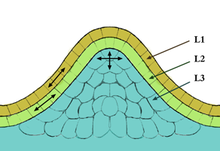growing point in buds. and at the tips of shoots and roots.
The meristem is a type of tissue found in plants. It consists of undifferentiated cells (meristematic cells) capable of cell division. Cells in the meristem can develop into all the other tissues and organs that occur in plants. These cells continue to divide until a time when they get differentiated and then lose the ability to divide.

Differentiated plant cells generally cannot divide or produce cells of a different type. Meristematic cells are undifferentiated or incompletely differentiated. They are totipotent and capable of continued cell division. Division of meristematic cells provides new cells for expansion and differentiation of tissues and the initiation of new organs, providing the basic structure of the plant body. The cells are small, with small vacuoles or none, and protoplasm filling the cell completely. The plastids (chloroplasts or chromoplasts), are undifferentiated, but are present in rudimentary form (proplastids). Meristematic cells are packed closely together without intercellular spaces. The cell wall is a very thin primary cell wall.
The term meristem was first used in 1858 by Carl Wilhelm von Nägeli (1817–1891) in his book Beiträge zur Wissenschaftlichen Botanik ("Contributions to Scientific Botany"). It is derived from the Greek word merizein (μερίζειν), meaning to divide, in recognition of its inherent function.[citation needed]
There are three types of meristematic tissues: apical (at the tips), intercalary or basal (in the middle), and lateral (at the sides). At the meristem summit, there is a small group of slowly dividing cells, which is commonly called the central zone. Cells of this zone have a stem cell function and are essential for meristem maintenance. The proliferation and growth rates at the meristem summit usually differ considerably from those at the periphery.
